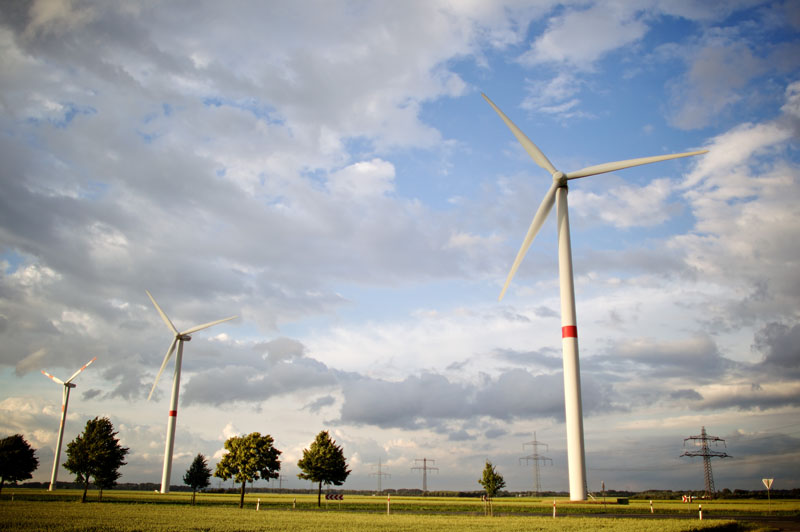On Sunday 8th May, Germany experienced a beautiful sunny day with high winds. Aside from enjoying the lovely sunshine, German citizens found themselves benefitting from a rather unexpected side effect:for a few hours, customers were actually being paid to consume energy. You read that right; in this era of spiralling energy costs and depleting supplies of fossil fuels, Germany had so much energy it had to pay people to get rid of it.
The ideal conditions for generating renewable energy saw wind, solar and hydroelectric plants produce an impressive 54.6GW of power. That’s around 80 per cent of the total 68.4GW power that Germany consumes. With a massive chunk of the country’s energy being generated from clean sources, there was a massive surplus of energy available in the system. Due to this, the cost of energy reached negative levels for around half of the day which prices hitting lows of -€130 per MWh.
This is clearly very impressive and indicates that there is a huge amount of potential in what can be achieved with renewable energy. We are in the midst of Germany’s energy revolution and it is embracing the new technologies that we are going to need to adopt over the coming years. The world has lots to learn by following the country’s example, so here are five lessons we can take from Germany’s renewable energy.

Lesson 1: Join up government policy
Firstly we need to look at how Germany has become a world leader in producing renewable energy. Thanks to a government initiative known as energiewende (German for ‘energy transition’), the country is taking energy very seriously.
In 2000, the net generation from renewable energy sources in Germany was around 6 per cent. In 2014 that figure had risen to more than 30 per cent. That’s a huge jump and it has most come about because of the policy of the government to prioritise renewables. Official figures show that there are now more than 370,000 people employed in the renewable energy sector and huge numbers of these jobs are attributed to the Renewable Energy Sources Act.
The true success of energiewende has come from the government understanding that it would need to work through different administrations to achieve its ambitious goals. The current targets look to 2050 and beyond, indicating that this is a generational challenge. This shows that if the rest of the world wants to follow Germany’s lead, they need to put aside petty politics to strive for a larger goal.
Lesson 2: Diversification is key
Part of the reason for the incredible turn of events that led to energy producers paying for their energy to be used came down to the amazing capacity of energy taken from solar PV panels. It is arguably solar power where Germany truly comes into its own. In 2014, Germany led the world in solar capacity with more than 38 gigawatts. In context, that’s more than the UK, the United States, France and Spain combined. The country gets so much power from its panels that it has been able to achieve almost 80 per cent of its power needs from solar alone.
You might assume that Germany’s dominance in the solar market means it has neglected other forms of energy, but actually a key to its success is the fact that it has diversified its renewables. In fact its wind capacity in 2014 was actually higher than solar at around 39 megawatts. A lot of money has also been put into hydroelectric and biomass energy sources. A broader profile of energy sources can only be a good thing.
Lesson 3: Tough goals lead to great results
In 2010, the German government released a policy document with regards to energiewende which set out a bold list of targets. These targets were even more ambitious than those set down by the EU. The paper stated that by 2020, renewable energy should make up 35 per cent of total electricity consumption in the country. For 2050, the target is 80 per cent. By 2015 that figure had already hit 33 per cent, so the country looks on target to achieve those figures.
The government also placed targets on greenhouse gas emissions. Taking 1990’s base figure, the governments wants to see a reduction of 40 per cent by 2020, and between 80 and 95 per cent by 2050. Some critics have suggested this target is unrealistic and unachievable but Germany has continued to surpass expectations.
Lesson 4: Don’t forget flexibility
So far, all of the lessons that we have taken from Germany’s energy revolution have been positive ones. But it’s also important to learn from the mistakes that have been made along the way. If we return to the point that Germany was having to pay people to consume energy, it might be easy to look at this purely as a good thing. But unfortunately it actually also points to a weak point in the system.
In a well-functioning energy system it should clearly never be the case that energy producers pay consumers to use their energy. That’s hugely unsustainable. The reason it happened was the fact many of Germany’s conventional power plants – specifically those running on coal and nuclear power – aren’t able to shut down quickly to stop producing energy. So that meant when the high levels of renewable energy were pushed into the system, they had nowhere for their energy to go.
Moving forward, Germany needs to gain more flexibility in the system so that traditional plants can shut down and compensate for large spikes in clean energy generation. If Germany could have improved their power storage technology and grid management, they would have been in a far better situation.
Lesson 5: It will be expensive – especially for citizens
Once again, you might imagine that all this incredible clean energy hanging around in the system has driven down energy prices across the country. But it’s not the case at all. In fact in 2014, German energy prices reached levels that are 48 per cent higher than the average in the EU. This is because the cost of energiewende is being passed on to consumers. According to some experts, the eventual cost of the policies will reach more than €1tn.



